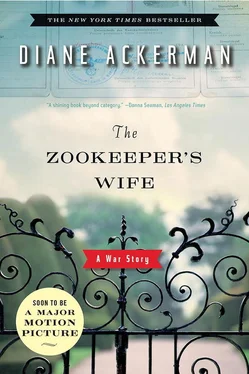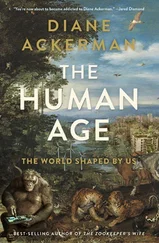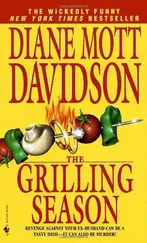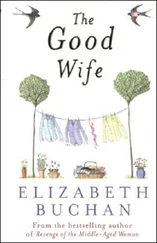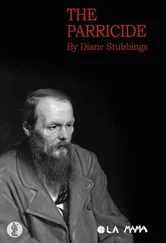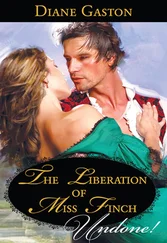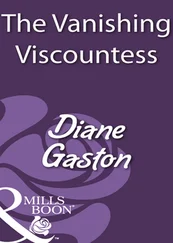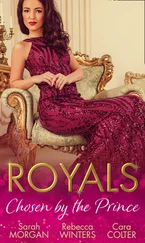The grasslands habitats included African wild dogs, excitable long-legged canines always on the run, swinging their wide heads and sniffing suspiciously as they swiveled large stiff ears. Their scientific name, Canis pictus (painted dog), suggests the beauty of their fur, randomly splotched with yellow, black, and red. But not their ferocity or endurance: they could drag down a bolting zebra or chase an antelope for miles. The zoo boasted the first in Europe, a real prize, even if in Africa farmers regarded them as vicious pests. In Warsaw they were picturesque showmen, no two patterned the same, and a crowd always formed in front of them. The zoo also bred the first Grewyi zebras, native to Abyssinia, which look familiar at first until you realize that, unlike textbook zebras, they’re taller and more heavily striped, with narrow bars that converge vertically around the body and run horizontally down the legs, striping all the way to the hooves.
And then there was Tuzinka, still covered in baby fuzz, one of only twelve elephants ever born in captivity. Hence her name, from tuzin, the Polish word for a dozen. Antonina had midwifed Kasia when she gave birth to Tuzinka, at 3:30 A.M. on a cool April morning. In her diary she described Tuzinka as a giant bundle, the largest baby animal she’d ever seen, weighing in at 242 pounds, standing a little over three feet tall, with blue eyes, a down of black hair, large pansy-like ears, a tail that seemed too long for her body—a wobbly confused newborn dropping into life’s sensory bazaar. Her blue eyes flickered with the same surprise Antonina beheld in the eyes of other newborn animals—gawking, fascinated, yet baffled by all the shine and clangor.
To nurse, Tuzinka stood beneath her mother, back knees bent, reaching up with her soft mouth. The look in her eyes signaled that nothing existed but the flow of warm milk and the drum of her mother’s reassuring heartbeat. That’s how photographers captured her, in 1937, for a black-and-white postcard that proved a popular souvenir, as did a stuffed cloth baby elephant. Old photographs show delighted visitors reaching out to Tuzinka and her mother, who is reaching back with an extended trunk, across a small moat edged with short metal spikes. Since elephants don’t jump, a six-foot-deep trench that’s six feet wide at the top and narrower at the bottom will trap them, provided the elephants don’t fill the trench in with mud and wade across, as some have been known to do.
Animal smells created the zoo’s olfactory landscape, some subtle, some almost sickening at first. Especially the scent signposts of hyenas, which turn their anal pouches inside out and ooze a stinky paste known in the trade as “hyena butter.” Each foul-smelling ad lasts a month or so, broadcasting news, and a mature male paints about a hundred fifty a year. Then there’s the hippo’s dominance display of defecating while propelling its little tail, flinging dung everywhere. Male musk oxen habitually sprinkle themselves with their own urine, and because sea lions trap rotting food between the teeth, their breath reeks a yard away. The kakapo, a black-feathered flightless parrot with a shocking white eye and orange beak, smells like an old clarinet case. During mating season, male elephants dribble a powerful sweet musth from a little gland near each eye. The crested auklet’s feathers smell of tangerine, especially during breeding season, when courting auklets poke their beaks into each other’s pungent neck-ruff. All the animals telegraph scent codes as distinctive as calls, and after a while, Antonina grew used to the thick aroma of their agendas—biological threats, come-ons, and news reports.
Antonina felt convinced that people needed to connect more with their animal nature, but also that animals “long for human company, reach out for human attention,” with a yearning that’s somehow reciprocal. Her imaginary transits into the Umwelt of animals banished the human world for a spell, a realm of saber-rattling and strife where parents suddenly vanish. Playing chase and tumble games with the lynx kittens, feeding them by hand, releasing herself to the sandy lick of warm tongues on her fingers and the insistent kneading of paws, as the no-man’s-land between tame and wild softened even more, helped her forge a bond with the zoo she described as “everlasting.”
The zoo also offered Antonina a pulpit for conservation, a sort of walking ministry, evangelism beside the Vistula as a tour of lesser gods, and she offered visitors a unique bridge to nature. But first they had to cross the cagelike bridge spanning the river and enter the woolier side of town. When she told them absorbing stories about lynxes and other animals, the earth’s vast green blur reeled into focus briefly as a single face or motive, a named being. She and Jan also encouraged directors to stage film, music, and theater events at the zoo, and loaned animals for roles in shows when asked—lion cubs being the most popular. “Our zoo was full of life,” she wrote. “We had lots of visitors: young people, animal lovers, and just visitors. We had many partners: universities in Poland and abroad, the Polish Health Department, and even the Academy of Fine Arts.” Local artists crafted the zoo’s stylized Art Deco posters, and the Żabińskis invited artists of all stripes to come and uncage their imaginations.
ONE DAY ON HIS BICYCLE ROUNDS OF THE ZOO, JAN LEFT ADAM the elk to graze on the lawn and shrubbery and entered the warm birdhouse, redolent with moist hay and lime. There, a petite woman stood close to a cage, moving her elbows in mimicry of the birds as they preened and posed. With her dark wavy hair, compact body, and thin legs sticking out from the hem of her smock, she almost qualified for enclosure herself. Bobbing on a trapeze overhead, a walleyed parrot screeched: “What’s your name? What’s your name?” And in a melodious voice, the woman piped back: “What’s your name? What’s your name?” The parrot leaned down and eyed her hard, then turned its head and fixed her with the other eye.
“Good day,” Jan said. Dzień dobry. It’s the way Poles began most polite verbal exchanges. She introduced herself as Magdalena Gross, a name Jan knew well, since Gross’s sculptures were commissioned by wealthy Poles and international admirers alike. [4] In 2003, Magdalena Gross’s sculpture Chicken was auctioned by the Piasecki Foundation to help raise money for autism research in Poland.
He didn’t know she sculpted animals, but then neither did she before that day. Later she’d tell Antonina that when she first visited the zoo she’d been so captivated that her hands had started molding air, so she decided to bring her tools and go on safari, and fate led her to that enclosure with birds streamlined like futuristic trains. Jan kissed her hand lightly according to Polish custom, said it would honor him if she considered the zoo her open-air studio and the animals her fidgety models.
By all accounts, tall, slender, fair Antonina looked like a Valkyrie at rest, and short, dark, Jewish Magdalena vibrated with energy. Antonina saw Magdalena as a winning array of contradictions: emphatic yet vulnerable, daring but modest, zany yet highly disciplined, someone excited by life—which may be what appealed most to Antonina, who wasn’t as stoic or solemn as Jan. The two women shared a passion for art and music, as well as a similar sense of humor, were close in age, and had friends in common—thus began what would become an important friendship. What would Antonina have served when Magdalena joined her for tea? Most Warsawians offer black tea and sweets to guests, and Antonina raised roses and jarred a lot of preserves, so at some point she’s bound to have prepared the traditional Polish pastry of soft doughnuts filled with a layer of pink rose-petal jam and coated in an orange glaze that smells of fire.
Читать дальше
